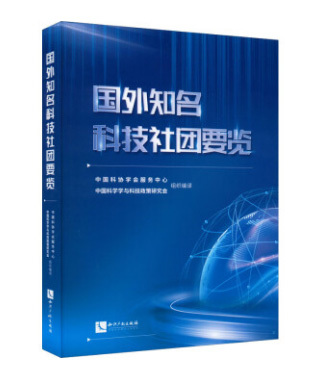Publications
Science of science research
Scientific research management
Science of Science and Management of Science and Technology
Innovation and Development Policy
Science Book Recommendation
- Science in China
- 2016-2017 Science and Technology Policy Discipline Development Report
- "Foreign well-known scientific and technological associations to see"
- Directory of Foreign Science and Technology Associations (Volume I)
- Directory of Foreign Science and Technology Associations (Medium Volume)
- Blue Book on the Development of Global Science and Technology Associations
Your current location:
"Foreign well-known scientific and technological associations to see"
"Foreign well-known scientific and technological associations to see"

In order to systematically grasp the basic situation of well-known science and technology associations in developed countries, under the organization of the Service Center of the Chinese Association for Science and Technology, the Chinese Society for Science and Technology Policy compiled the book "A Survey of Well-known Foreign Science and Technology Associations. This book collects the basic information of about 500 well-known science and technology associations in 23 countries, including the United States, Australia, the United Kingdom, Canada, France, Japan and South Korea, and integrates and classifies the basic information of these science and technology associations, involving science, industry, agriculture, medicine and interdisciplinary fields, it covers six aspects: basic information, historical evolution, vision and mission, governance structure, membership, periodicals and awards. The relevant data and information statistics covered in this book are due in June 2021. It is hoped that the publication of this book will provide information support for deepening the governance reform of China's science and technology associations, so that more researchers, leaders and professionals in related fields can obtain the information of well-known science and technology associations in various countries, and provide reference and enlightenment for the construction and development of China's science and technology associations.
Science and technology community is the main form of social institutionalization of science and technology. In the mid-17th century, national science and technology societies began to emerge in England, Germany and France. In order to get rid of the shackles of traditional religious thought, the outstanding scientists of various countries pursued and developed scientific truth through the "invisible college", which was later catalyzed by the spirit of association to become a fixed organization, and finally became a legalized social organization after being recognized by the government. After a long and tortuous historical change, most scientific and technological associations have become non-profit legal persons protected by law with the support of the government. Science and technology associations usually take the general assembly composed of all members as the highest power and decision-making organ, the board of directors and the standing council are responsible for the daily management, and the operating body is a branch composed of various disciplines. Science and technology associations establish contact with the government, science and technology circles, and the public through formal and informal channels to participate in science and technology governance. In the past 300 years, science and technology associations have played an important role in the development of world science and technology.
In today's era, science and technology associations have gradually become one of the important forces in global science and technology governance. The deepening of globalization provides an opportunity for scientific and technological associations to cross national and disciplinary boundaries and cooperate to solve common problems facing mankind. As a stage for scientists to exchange scientific discoveries and present academic achievements, science and technology associations have played an important role in global science and technology governance by virtue of their open and inclusive characteristics. Today's world is undergoing great changes unseen in a century, and the development environment, organizational functions and historical missions of global science and technology associations are facing profound and complex changes. Science and technology associations in developed countries such as the United Kingdom, the United States, Germany, and Japan actively explore living space and promote the process of internationalization. A large number of science and technology associations with vitality and international influence have continuously emerged, which are important to the development of national innovation systems and international scientific and technological exchanges in various countries. Cooperation plays a greater role in promoting.
At present, China's science and technology associations are facing new opportunities and challenges, and need to better shoulder the new missions and responsibilities entrusted by the times. At the same time, with the acceleration of the new round of world science and technology and industrial revolution, the global economic and political pattern and the situation of international scientific and technological cooperation and exchange have been profoundly adjusted. As practitioners of the concept of science without borders and science without discrimination, science and technology associations are becoming important contributors to global science and technology governance. my country's science and technology associations have made considerable development and progress. There are more than 300 national-level science and technology associations that can be retrieved by the national non-governmental organization management department. There are a large number of science and technology associations in all provinces, cities, and counties, covering various disciplines and fields., Various industries. The science and technology associations in developed countries started earlier, and have formed a good accumulation in the development process, organizational form and professional field. A comprehensive understanding of the general picture of science and technology associations in various countries and learning their development path and experience can provide ideas and reference for the development of science and technology associations in China.
The introduction of science and technology associations in various countries in this book is based on open and available information. Limited by objective conditions, the writing team still has certain deficiencies in collecting relevant information. Therefore, there are inevitably deficiencies and flaws in this book. Readers are urged to criticize and correct.









